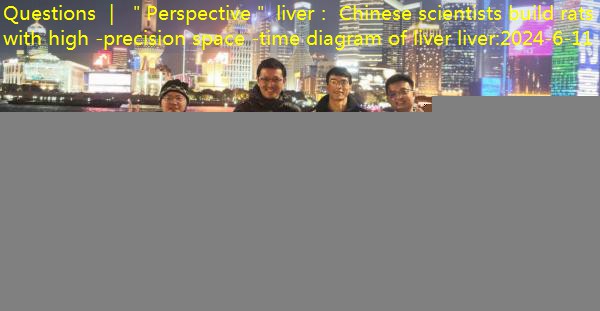Questions | "Perspective" liver: Chinese scientists build rats with high -precision space -time diagram of liver liver
· For the first time, the high -precision space -time map of the liver of mice was successfully constru

· For the first time, the high -precision space -time map of the liver of mice was successfully constructed, and the molecular mechanism of the spatial molecular molecular characteristics of the liver and the damage repair of the liver provided new ideas for the treatment of liver disease in the future.
Among all organs, the liver may be the most “mysterious”.It is not only the largest physical organs, contains the most blood, has the strongest regeneration capabilities in the organs, but also assumes various functions such as metabolism, synthesis, digestion, and immunity.
The ancients once thought that liver represents desire, emotional impulse, and vitality itself.In the eyes of modern scientists, the physiological mechanism of the liver is the result of diverse cells under the guidance of genes.There are too many unsolvable mysteries for these complex mechanisms.
With the development of science and technology such as gene sequencing and computer, people are expected to explore these puzzles through more accurate and in -depth observation technologies.On April 16, 2024, the Hangzhou Huada Life Sciences Research Institute and the Chinese Academy of Sciences Molecular Cyne Science Innovation Center, united with domestic and foreign institutions such as Jilin University, the Fifth Affiliated Hospital of Guangzhou Medical University, Shanxi Medical University, Shanghai University of Science and Technology, and other domestic and foreign institutions.The international journal “Nature Genetics” published two research results. For the first time, it successfully constructed the high -precision time and space map of the liver of mice, exploring the molecular mechanism in the spatial molecular characteristics of the liver and the repair of damage.The treatment of disease provides new ideas.
With the help of Huada ’s self-study Stereo-SEQ time and space group, researchers combine the spatial information of liver cells with molecular information such as cell genes in terms of nano-level resolution, and conduct deep perspectives and in the liver.Modeling.In one of the studies, researchers conducted research on the normal liver of mice and the liver after 70%resection, revealing the cell types, gene expression and micro -ring signal in the stable liver, as well asHow to coordinate and accurate liver regeneration after some liver resection.
There are different types of cells in different areas of the liver. They differentiate under gene guidance, exercise different functions, and cooperate with each other through a series of mechanisms.The research team analyzes the genetic distribution characteristics of different types of liver cells on the door vein of the liver-central vein shaft, and identifies a series of genetic distribution genes.
In addition, the team also discovered for the first time that there was an immune microstructure of about 50-200 microns in the liver. It located and parsed the immune cell composition of it. It was found that T cells and monocytes were mainly composed of T cells and monocytes.The research team speculates that it may be a special mechanism for liver immune response, which can help liver to resist exogenous bacteria or antigens.
In another study, the researchers observed the molecular process of the liver during self -repair after the help of the same technology.Bile stasis is caused by bile secretion and excretion disorders. In severe cases, it may lead to a series of diseases such as cholecystitis, cirrhosis, and liver failure.After this injury occurs, the hepatocytes in the door of the liver will be repeatedly programmed as the ancestral ancestor -like cell (LPLC) to contribute to the proliferation of liver cells.In this study, scientists have observed the characteristics of damage in the process and the characteristics of time and space dynamic changes in micro -environmental signals.
How does modern science understand liver function?How will these two studies deepen our understanding of liver disease?What is the difference between the liver of mice and human liver?What exactly is the time and space group?In order to answer these questions, Surging Technology reporters interviewed many researchers in the research team.

Members of the team of Hangzhou Huada Life Sciences (from left) Xu Jiangshan, Hao Shijie, and Guo Pengcheng are doing experiments.Interviewee confession

Members of the Team of Molecular Cympaic Innovation Center of the Chinese Academy of Sciences (from left) Shen Tu Xinyi, Researcher Huili Jian, Nan Haitao and Wu Baihua.Interviewee confession
【dialogue】
Liver under the perspective of genes and cells
Surging Technology:What are the main aspects of the liver?
Xu Jiangshan (liver steady state-liver cutting-regenerative space-time diagram thesis co-first author, associate researcher at Hangzhou Huada Life Science Research):The liver is one of the most important metabolic organs in the human body. It participates in metabolism and regulation of protein, fat and carbohydrates.It has a detoxification function and can remove harmful substances and metabolites in the body.In addition, the liver can synthesize many important biological activates, such as albumin, cholesterol, bile acid, and coagulation factor.
The liver is composed of his basic structural unit liver lobular. Each liver lobe is similar to a three -dimensional positive hexagonal structure. The central vein is located in the center of the positive hexagonal.Flow from the peripheral vertex to the center.With blood flow, oxygen and nutrients have gradually been absorbed and metabolized by liver cells, forming its unique continuous gradient distribution of oxygen and nutrients, that is, liver zonation.This partition is actually the basis for the division of labor in the exercise of liver cells. For example, the liver cells near the central vein are mainly responsible for detoxifying function, and the liver cells near the surrounding door vein are mainly responsible for albumin synthesis. This division of labor also guarantees liver functionThe efficient exercise also brings the disease of the disease to the liver cells in different regions.

Basic structure of the liver.Interviewee confession
In this study, using the STEREO-SEQ unique to Wasteen ’s unique space-time group, we have carefully analyzed the space-time dynamics of the liver in this functional partition under the condition of steady-state, damage and regeneration, including the composition of cell types in the liver and its spaceThe distribution situation, gene expression spatial information, and which genetic expression has the characteristics of liver partition, and explores the inner genetic network and micro -environmental characteristics based on this.
Surging Technology:The article mentioned that the coordinated response mechanism of animal liver during the tissue stability and disturbances is unclear, which has caused us to understand many diseases.Can you introduce how to communicate and collaborate between the cells in the theory?What role does gene play in it?Why do we understand that these phenomena can deepen our awareness of disease?
Xu Jiangshan:The communication between cells generally refers to the micro -ring characteristics of the cells, including the cells through secreting signal molecules (such as hormones, growth factor), direct contact (such as macrophages), or indirectly participating in the micro -involved through the secretion of extracellular matrix.environment.
These micro -loop factors and cell interactions affect the function and behavior of cells. For exampleEssenceDifferent gene expression modes can cause different states and functions of cells, which will affect the functions of the entire tissue and organs.
Understanding inter -cell communication and collaboration is very important for our cognitive diseases.For example, in hepatitis and liver fibrosis, the disorders of inflammation and fibrosis signals can cause communication disorders between liver cells and non -liver cells, which in turn leads to continuous activation of inflammatory reactions and excessive deposits of fibrosis.Similarly, in liver cancer, communication disorders between liver cells and peripheral immune cells may affect the growth and metastasis of the tumor.
Surging Technology:Study using mice’s liver. Is it similar to human liver cells as human liver cells?Why not directly study human liver tissue?
Hao Shijie (the first author of the article, a doctoral student of the Hangzhou Huada Life Science Research Institute):The liver has evolved from the common ancestors of vertebrates. Of course, it is also a conservative organ of mammals. Therefore, the composition of the cells of the liver and human liver is very similar to the characteristics of the liver and human liver.
However, human research is limited to individual differences in gender, diet, age and other individuals, and it is difficult to obtain universal laws.And the related research of damage and regeneration is difficult to develop on the human body. Therefore, the first step is to use the controllable model animals of mice first to study.In the next step, we will also extend the various degenerative conditions of human liver, such as liver disease (such as fatty liver, fibrosis) or aging.
Space Group Study Technology: Integration of genetic information and space information
Surging Technology:Can you introduce the STEREO-SEQ technology used by the Institute?How long does it take to draw the map generated in the study?What information does it mainly reflect?
Shangguan Shuncheng (liver steady-state-liver cutting-regenerative space-time diagram papers joint first author, Shenzhen Huada Life Science Research Institute Biochemical Engineer):Space group science technology is a method for studying tissue or intracellular gene expression. It combines the analysis of space information and transcription groups.Traditional transcription groups usually only provide the overall information of gene expression, and cannot provide spatial distribution information in cell or tissue gene expression.The spatial transcription group provides the spatial positioning information of gene expression by fixing tissue or cells in its original position.The development of this technology provides researchers with a more comprehensive and more accurate way to understand gene expression.
The STEREO-SEQ technology used in this study uses space-time chips independently developed by Huada.The chip is covered with a DNA nano -nano -ball of hundreds of millions of rules array -type, 500 nanometer between each nanometer (the accuracy of the same method in the past is 10 μm), and each ball has its own unique label, Used to mark specific space location information.The researchers used chips with location information to combine fresh tissue freezing slices. After a series of steps, the genes in the cell captured and expanded into nucleic acid libraries and sequenced.After the data processing steps of the space -time cloud platform, the real -time gene expression information of the captured cells can be corresponding to the space and location information on the chip, that is, the space -time transcription map of the liver tissue slices is obtained.

Liver injury and time and space in the process of liver injury and repair.Interviewee confession
In this study, the generation of data took less than one month, but the interpretation of biological significance it took a long time.This may also be the future trend, and the speed of generating data far exceeds the development of conventional interpretation capabilities. This may be why we need artificial intelligence assistance.With unprecedented data depth and breadth, these maps analyze the time and space changes of the liver in steady -state, damage and regeneration.
Surging Technology:What are the development directions of this technology in the future?Can it be applied to other organs?What are the limitations?
Lai Yiwei (the author of the joint communication and associate researcher of the Hangzhou Huada Life Sciences Research Institute):Further, we hope that based on existing research, experts in the field of liver fields at home and abroad are to apply new grouping technical methods to the problems of clinical liver metabolic diseases, cancer, aging and other issues to solve practical clinical problems, Find new methods for the treatment of diseases and promote liver repair; on the other hand, focusing on liver research, developing new testing technologies, expanding the current spatial transcription team to more comprehensive space multi -dimensional learning information, and using deep learning, etc.The new artificial intelligence technology finally builds a digital liver model.
This technology has actually been used in multiple organs. For example, we use the time and space group STEREO-SEQ to cooperate with the Chinese Academy of Sciences and Institute of Innovation (Institute of Neuroscience), led by Academician Pu Muming to build crab and monkeys3D diagram of the whole cerebral cortex; it is also cooperating with Jinfeng Labs, hoping to develop digital pathology in combination with STEREO-SEQ on the basis of traditional pathology.In the future, we also hope that this technology can develop information from only for transcriptional analysis to information that can capture more dimensions at the same time.
“Perspective” liver: structure and mechanism under “high -definition camera”
Surging Technology:Can you introduce a number of new discoveries in the liver steady -state spectrum?
Lai Yiwei:We not only make a comprehensive identification of genetic gradient distribution characteristics of the gene gradient distribution of liver cells, but also make a comprehensive identification of the genetic distribution of endothelial cells and star cells, and find a large number of genes that have not been reported to have this feature.
For example, in liver cells, we found that the hepatitis B virus NTCP has very high expression characteristics in the hepatocytes around the central vein, which also explains why hepatitis B virus accumulates more in the hepatocytes near the central vein.This also provides a reference for us to design the treatment of liver disease.
Surging Technology:For the first time, the study also found a kind of immune microstructure in the liver. Can you introduce it?
Guo Pengcheng (the first author of the article, the post -doctoral post doctors of the Hangzhou Huada Life Sciences):We believe that this micro -structure has been continuously observed in the past, but in the observation of morphology, past research has not been able to summarize its true characteristics.
With the help of time and space group Stereo-SEQ, we not only find that the immune microstructure that is randomly distributed in the liver is composed of T cells and monocytes. It is also found that these cells have downstream genetic signs in response to interferon γ.Therefore, we guess the existence of this structure can maintain the ability of the liver to quickly respond to exogenous pathogen infections, so that the liver can quickly remove the pathogen.We dug past studies and found that similar immune micro -structures were also identified in skin and colorectal.However, its real function and mechanism still needs to be studied.
Surging Technology:The study also analyzed the coordination process of various cells in the liver in the liver regeneration process, and found a inflammatory induced regulatory factor TBL1XR1.Can you introduce it?
Guo Pengcheng:TBL1XR1 is an auxiliary factor of a transcription factor (can combine DNA in a sequence -specific way and adjust the transcription of protein). At present, it is believed that this factor participates in the liver’s fat decomposition metabolic regulation.There is a relationship with the occurrence of liver cancer.
In our research, we found that TBL1XR1 will be activated after liver resection. If we interfere with the activation of this factor, liver regeneration will be suppressed.Therefore, we believe that TBL1XR1 is a important regulatory factor that promotes liver regeneration.This also provides new targets for clinically regulating TBL1XR1 to promote liver regeneration to achieve the treatment of liver disease or liver cancer.
Surging Technology:In the study of bipyle stasis, researchers found that bile duct cells acted as signal “hub” in regional damage and liver cell regeneration.Can you introduce this disease and describe these processes?
Wu Baihua (the first author of bile stasis damage and regeneration spelling spectrum paper, doctoral students of Huili Jian Research Team of the Molecular Cympaic Innovation Center of the Chinese Academy of Sciences):Clinically, bile stasis diseases mainly include primary bileproof bile tubulitis (PBC) and primary sclerosis cholecostitis (PSC), biliary locks, etc.Its main feature is the damage of bile duct cells and hepatocytes in the venous region. With the infiltration and fibrosis of immune cells, it can gradually develop to cirrhosis, liver failure and even death.The pathogenesis of cholesticine accumulation is currently unclear, and the clinical effective treatment plan is limited. Therefore, the pathogenesis of choopic stasis is urgent to determine the new treatment target.
Bile stasis disease usually has a significant gathering of various immune cells and matrix cells in the gate varicose vein area. Such complex and diverse cells gather in the door venous region will strongly affect the damage response of the micro -environment.Bile stasis damage.So what cells dominate the remodeling of the immunomotized component of the door vein area?
Through the high -definition camera of a “high -definition camera”, we “took” the composition and expression of the damaged regional cells one by one.What surprised us was that compared to the type of cells that were active under the tradition, such as macrophages, fibroblasts, and hepatotinotyle endothelial cells, bile duct cells wereHighlights.Specifically, we found that bile duct cells secrete a series of tendred factors, which strongly attract immune cells, and at the same time affect the maturity of LAM (lipid -related macrophages) in the damage area.
In addition, our data also reveals different sub -type liver -like cells (LPLCs).So what is LPLC?In the previous work, the researchers found that the liver cells under the damage of bile stasis will be redistributed to LPLC. The liver cells in this state have the characteristics of some liver ancestral cells and can be differentiated into liver cells or bile ducts. This attribute change is important.Can contribute liver regeneration.
But what factors make part of LPLC into liver cells and part of them into bile duct cells?Among the two types of LPLC identified by our group, we found that LPLC2 is similar to cholecusal cells on the expression spectrum.In terms of space, we once again used the “high -definition camera” to capture. Compared with LPLC1, LPLC2 is closer to the bile duct area in the position, which implies that there may be interaction between LPLC2 and bile duct cells.Further analysis found that bile duct cells strongly express the TGF family factor related to the transition from hepatocytes to bile ducts.This indicates that the bile duct cells are highly related to the transition of LPLC2 to the bile duct spectrum.
Surging News reporter Ji Jingjie
(This article comes from surging news, please download the “Surging News” APP for more original information)
Report/feedback






